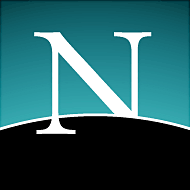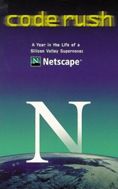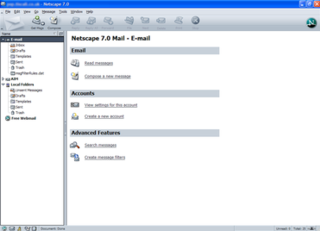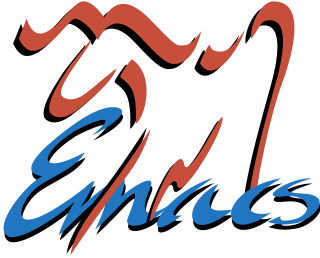Related Research Articles
The editor war is the rivalry between users of the Emacs and vi text editors. The rivalry has become an enduring part of hacker culture and the free software community.
Netscape Communications Corporation was an American independent computer services company with headquarters in Mountain View, California, and then Dulles, Virginia. Its Netscape web browser was once dominant but lost to Internet Explorer and other competitors in the so-called first browser war, with its market share falling from more than 90 percent in the mid-1990s to less than one percent in 2006. An early Netscape employee Brendan Eich created the JavaScript programming language, the most widely used language for client-side scripting of web pages and a founding engineer of Netscape Lou Montulli created HTTP cookies. The company also developed SSL which was used for securing online communications before its successor TLS took over.

XEmacs is a graphical- and console-based text editor which runs on almost any Unix-like operating system as well as Microsoft Windows. XEmacs is a fork, based on a version of GNU Emacs from the late 1980s. Any user can download, use, and modify XEmacs as free software available under the GNU General Public License version 2 or any later version.
Gosling Emacs is a discontinued Emacs implementation written in 1981 by James Gosling in C.
Feature creep is the excessive ongoing expansion or addition of new features in a product, especially in computer software, video games and consumer and business electronics. These extra features go beyond the basic function of the product and can result in software bloat and over-complication, rather than simple design.

XScreenSaver is a free and open-source collection of 240+ screensavers for Unix, macOS, iOS and Android operating systems. It was created by Jamie Zawinski in 1992 and is still maintained by him, with new releases coming out several times a year.

Netscape 6 is a discontinued Internet suite developed by Netscape Communications Corporation, and was the sixth major release of the Netscape series of browsers. It superseded Netscape Communicator (4.x), as the release of Netscape Communicator 5 was scrapped. Netscape 6 was the first browser of the Netscape line to be based on another source code: Mozilla Application Suite, an open-source software package from the Mozilla Foundation, which was created by Netscape in 1998.

Brendan Eich is an American computer programmer and technology executive. He created the JavaScript programming language and co-founded the Mozilla project, the Mozilla Foundation, and the Mozilla Corporation. He served as the Mozilla Corporation's chief technical officer before he was appointed chief executive officer, but resigned shortly after his appointment due to controversy over his opposition to same-sex marriage. He subsequently became the CEO of Brave Software.
The history of the Mozilla Application Suite began with the release of the source code of the Netscape suite as an open source project. Going through years of hard work, Mozilla 1.0 was eventually released on June 5, 2002. Its backend code base, most notably the Gecko layout engine, has become the foundation of a number of applications based on Mozilla, including the Mozilla Foundation's flagship product Mozilla Firefox and Mozilla Thunderbird. While the suite is no longer a formal Mozilla product, its development and maintenance is continued as the SeaMonkey community project.
Richard P. Gabriel is an American computer scientist known for his work in computing related to the programming language Lisp, and especially Common Lisp. His best known work was a 1990 essay "Lisp: Good News, Bad News, How to Win Big", which introduced the phrase Worse is Better, and his set of benchmarks for Lisp, termed Gabriel Benchmarks, published in 1985 as Performance and evaluation of Lisp systems. These became a standard way to benchmark Lisp implementations.
Lucid Incorporated was a Menlo Park, California-based computer software development company. Founded by Richard P. Gabriel in 1984, it went bankrupt in 1994.
Mork is a computer file format used by several email clients and web browsers produced by Netscape, and later, Mozilla Foundation. It was developed by David McCusker with the aim of creating a minimal database replacement that would be reliable, flexible, and efficient, and use a file format close to plain text.

Code Rush is a 2000 documentary following the lives of a group of Netscape engineers in Silicon Valley. It covers Netscape's last year as an independent company, from their announcement of the Mozilla open source project until their acquisition by AOL. It particularly focuses on the last-minute rush to make the Mozilla source code ready for release by the deadline of March 31, 1998, and the impact on the engineers' lives and families as they attempt to save the company from ruin.

The Netscape web browser is the general name for a series of web browsers formerly produced by Netscape Communications Corporation, which eventually became a subsidiary of AOL. The original browser was once the dominant browser in terms of usage share, but as a result of the first browser war, it lost virtually all of its share to Internet Explorer due to Microsoft's anti-competitive bundling of Internet Explorer with Windows.

Netscape Mail and Newsgroups, commonly known as just Netscape Mail, was an email and news client produced by Netscape Communications Corporation as part of the Netscape series of suites between versions 2.0 to 7.2. In the 2.x and 3.x series, it was bundled with the web browser. In the 4.x series, it was rewritten as two separate programs known as Netscape Messenger and Netscape Collabra.
A rewrite in computer programming is the act or result of re-implementing a large portion of existing functionality without re-use of its source code. When the rewrite is not using existing code at all, it is common to speak of a rewrite from scratch.

GNU Emacs is a free software text editor. It was created by GNU Project founder Richard Stallman, based on the Emacs editor developed for Unix operating systems. GNU Emacs has been a central component of the GNU project and a flagship project of the free software movement. Its name has occasionally been shortened to GNUMACS. The tag line for GNU Emacs is "the extensible self-documenting text editor".

Emacs, originally named EMACS, is a family of text editors that are characterized by their extensibility. The manual for the most widely used variant, GNU Emacs, describes it as "the extensible, customizable, self-documenting, real-time display editor". Development of the first Emacs began in the mid-1970s, and work on its direct descendant, GNU Emacs, continues actively; the latest version is 28.2, released in September 2022.

Mozilla is a free software community founded in 1998 by members of Netscape. The Mozilla community uses, develops, spreads and supports Mozilla products, thereby promoting exclusively free software and open standards, with only minor exceptions. The community is supported institutionally by the non-profit Mozilla Foundation and its tax-paying subsidiary, the Mozilla Corporation.
References
- ↑ Zawinski, Jamie (2000-02-11). "The Lemacs/FSFmacs Schism" . Retrieved 2023-05-01.
- ↑ "List of screen savers included in the collection". XScreenSaver. 2020-12-08. Retrieved 2021-02-13.
- ↑ "Release history". XScreenSaver. 2020-12-08. Retrieved 2021-02-13.
- ↑ "Netscape Navigator's "about:authors" page". 1994-12-15. Retrieved 2021-02-13.
{{cite web}}: CS1 maint: url-status (link) - ↑ Steinert-Threlkeld, Tom (1995-10-31). "Can You Work in Netscape Time?". Fast Company magazine.
- ↑ Zawinski, Jamie (2017-11-20). "HTML email, was that your fault?". jwz.org blog. Retrieved 2021-02-13.
{{cite web}}: CS1 maint: url-status (link) - ↑ Zawinski, Jamie (1996). "The Netscape Dorm". jwz.org. Retrieved 2021-02-13.
- ↑ Dave Titus with assistance from Andrew Wong (2002-12-01). "How was Mozilla born: The story of the first mascot on the Internet" . Retrieved 2023-05-01.
- ↑ Zawinski, Jamie (2011-12-03). "The secret history of the about:jwz URL". jwz.org. Retrieved 2021-02-13.
- ↑ Suárez-Potts, Louis (2001-05-01). "Interview: Frank Hecker". OpenOffice. Archived from the original on 2001-08-07. Retrieved 2021-02-13.
- 1 2 Moody, Glyn (2001-02-18). Rebel Code: Linux and the Open Source Revolution. Basic Books. ISBN 978-0-7867-4520-3.
- ↑ Jim Hamerly and Tom Paquin with Susan Walton (1999-01-03). "Freeing the Source: The Story of Mozilla". Open Sources: Voices from the Open Source Revolution. O'Reilly Media, Inc. ISBN 978-0-596-55390-6.
- ↑ Boutin, Paul (July 1998). "Electric Word: Mozilla.organizer". Wired. Vol. 6, no. 7.
- ↑ Quittner, Josh (1998-03-23). "Netscape's Hail Mary". Archived from the original on 2002-02-23.
- ↑ Zawinski, Jamie (1998-11-23). "Fear and loathing on the merger trail". Mozilla . Retrieved 2013-04-29.
- ↑ Zawinski, Jamie (1999-03-31). "Resignation and postmortem". Archived from the original on 2004-08-07. Retrieved 2013-03-29.
- ↑ Festa, Paul (1999-04-01). "AOL, Mozilla lose key evangelist". CNET. Retrieved 2021-02-13.
- ↑ Knauss, Greg (2000-11-07). "Hacking the City". Stating the Obvious. Retrieved 2021-02-13.
- ↑ Leonard, Andrew (2000-02-10). "Free the night life!". Salon . Retrieved 2013-04-29.
- ↑ Thomas, Evany (2001-07-16). "From Netscape to Nightclub". Wired. Archived from the original on 2008-04-09. Retrieved 2021-02-13.
- ↑ Strachota, Dan (2001-07-18). "Revenge is Sweet". SF Weekly. Archived from the original on 2021-09-23. Retrieved 2021-02-13.
- 1 2 Pereira, Alyssa (2016-12-19). "Owner of DNA Lounge, on verge of closing club, calls for 'ideas' to keep it open". SF Gate.
- ↑ Thomas, Evany (2001-07-16). "From Netscape to Nightclub". Wired.
- ↑ Joshua Quittner; Michelle Slatalla (1998). Speeding the Net: The Inside Story of Netscape and How It Challenged Microsoft. Atlantic Monthly Press. ISBN 978-0-87113-709-8.
- ↑ Seibel, Peter (2009-09-16). Coders at Work: Reflections on the Craft of Programming. Apress. ISBN 978-1-4302-1948-4.
- 1 2 Seibel, Peter. "Coders at Work". Apress. Retrieved 1 May 2023.
- ↑ "California Dreamin': The Gold Rush". ColourFIELD. 2001. Retrieved 2023-05-01.
- ↑ "California Dreamin': The Gold Rush (video)". Colorfield. 2001. Retrieved 2023-05-01.
- ↑ "Revolution: The First 2000 Years of Computing". Computer History Museum. 2011. Retrieved 2021-02-13.
- ↑ "Jamie Zawinski Interview". Sleep Mode: The Art of the Screensaver. 2017-01-27. Retrieved 2020-12-24.
- ↑ Eric S. Raymond The Art of UNIX Programming, p.313
- ↑ Raymond, Eric S. (2003-12-29). "The Jargon File". Jargon File Text Archive. Retrieved 2023-05-01.
- ↑ Zawinski, Jamie [@jwz] (2020-11-24). "My point was not about copycats, it was about platformization" (Tweet). Retrieved 2021-02-13– via Twitter.
- ↑ Seibel, Peter (2009-10-16). "C++ in Coders at Work". Gigamonkeys. Archived from the original on 2010-09-22. Retrieved 2013-04-29.
- ↑ Zawinski, Jamie (2013). "jwzhacks" . Retrieved 2013-04-29.
- ↑ Friedl, Jeffrey (2006-09-15). "Source of the famous "Now you have two problems" quote". regex.info. Retrieved 2023-05-01.
- ↑ Zawinski, Jamie. "Java sucks". jwz.org. Archived from the original on 2000-06-16. Retrieved 2013-04-29.